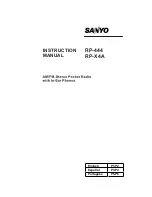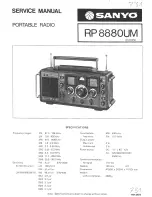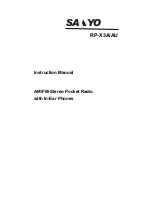
56
Description
TM8100/TM8200 Service Manual
© Tait Electronics Limited
November 2007
2.5.3
Audio Processing and Signalling
Audio Processing
Raw demodulated data from the receiver is processed within the DSP.
The sample rate at this point is 48kHz with signal bandwidth limited only
by the IF filtering. Scaling (dependent on the bandwidth of the RF channel)
is then applied to normalize the signal level for the remaining audio
processing. The sample rate is decimated to 8kHz and 0.3 to 3kHz bandpass
audio filtering is applied. De-emphasis is then applied to cancel out the
receive signals pre-emphasized response and improve signal to noise
performance. Optional processing such as decryption or companding is then
applied if applicable.
Data and Signalling
Decoders
The data and signalling decoders obtain their signals from various points
within the audio processing chain. The point used depends on the decoders’
bandwidth and whether de-emphasis is required. Several decoders may be
active simultaneously.
Side Tones
Side tones are summed in at the end of the audio processing chain. These are
tones that provide some form of alert or give the user confidence an action
has been performed. The confidence tones may be generated in receive or
transmit mode. The sidetone level is a fixed proportion (in the order of
-10dB) relative to full scale in the receive path.
CODEC
The combined audio and side-tone signal is converted to analog form by a
16-bit DAC with integral anti-alias filtering. This is followed by a
programmable-gain amplifier with 45dB range in 1.5dB steps, that performs
primary volume control and muting. The DAC and primary volume control
are part of the same CODEC device (AD6521).
Output to Speakers
The output of the CODEC is fed to an audio power amplifier via a
secondary volume control (not TM8100 radios) and to the control head via
a buffer amplifier. The output configuration of the audio power amplifier is
balanced and drives an internal speaker in non-remote control-head
configuration and, optionally, an external speaker. The speaker loads are
connected in parallel rather than being switched. The power delivered to
each speaker is limited by its impedance. The internal speaker has 16
Ω
impedance whereas the external speaker can be as low as 4
Ω
.
Volume Control
Configurations
There are two volume controls in the TM8200 radio but only one is active
at any time when audio is being output to the speaker(s). The inactive
volume control is set to maximum. For non-remote control-head
configuration, the primary volume control is active. For remote control-
head configuration, the secondary volume control is active. This enables
fixed level audio feed to the remote control head, and independent volume
control of the external speaker and the speaker of the remote control head.
Summary of Contents for TM8100 mobiles
Page 1: ...TM8100 mobiles TM8200 mobiles Service Manual MMA 00005 05 Issue 5 November 2007...
Page 10: ...10 TM8100 TM8200 Service Manual Tait Electronics Limited November 2007...
Page 12: ...12 TM8100 TM8200 Service Manual Tait Electronics Limited November 2007...
Page 20: ...20 Introduction TM8100 TM8200 Service Manual Tait Electronics Limited November 2007...
Page 64: ...64 Description TM8100 TM8200 Service Manual Tait Electronics Limited November 2007...
Page 106: ...106 TM8100 TM8200 Service Manual Tait Electronics Limited November 2007...
Page 134: ...134 General Information TM8100 TM8200 Service Manual Tait Electronics Limited November 2007...
Page 168: ...168 Servicing Procedures TM8100 TM8200 Service Manual Tait Electronics Limited November 2007...
Page 464: ...464 Spare Parts TM8100 TM8200 Service Manual Tait Electronics Limited November 2007...
















































